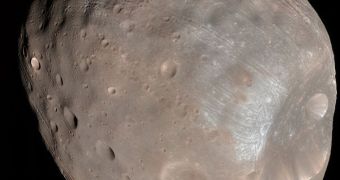The wreckage of the Phobos-Grunt spacecraft haven't yet even settled at the bottom of the ocean, but officials at the Russian Federal Space Agency (RosCosmos) are already revealing new plans to send a spacecraft to the diminutive Martian moon.
It's hard to say what drives the Russians in this quest, since they have been trying to get to Phobos for more than two decades now. Each of their attempts failed, and the latest sample-return mission was no different. The spacecraft launched in November, and fell back to Earth in January.
Phobos-Grunt most likely failed due to massive electromagnetic interferences, which prevented it from activating its main engine, and leaving Earth's orbit. It was therefore trapped on a slowly-decaying path which eventually saw reentering the planetary atmosphere earlier this month.
RosCosmos is however ready to get back on that Mars, according the agency's chief, Vladimir Popovkin. He said during a recent conference that another sample-return mission would be created and launched if the European Space Agency (ESA) did not include Russian in the ExoMars program.
“We are holding consultations with the ESA about Russia’s participation in the ExoMars project […] If no deal is reached, we will repeat the attempt [to launch a Phobos mission],” Popovkin explained.
The ExoMars mission consists of the ExoMars Trace Gas Orbiter – a spacecraft destined to analyze where Mars' methane is resupplied from – and a robotic rover, which is scheduled to launch for the Red Planet around 2018, Daily Galaxy reports.
Originally, the project was supposed to be conducted by NASA and ESA, but the American space agency decided to pull out on account of insufficient funds. It was supposed to provide the Atlas V delivery system for both ESA spacecraft.
RosCosmos could supply a Proton rocket for the same applications, if ESA agrees to give it full membership privileges in the program.
One of the reasons why every space agency is so interested in Phobos could be the inner cavities that may exist within the moon. Some say that they may be large and air-tight enough to hold on to an atmosphere. This raised the prospect that the moon is an artificial satellite of Mars.
There is no way of testing whether that is true or not, investigators say, until a spacecraft gets there.

 14 DAY TRIAL //
14 DAY TRIAL //